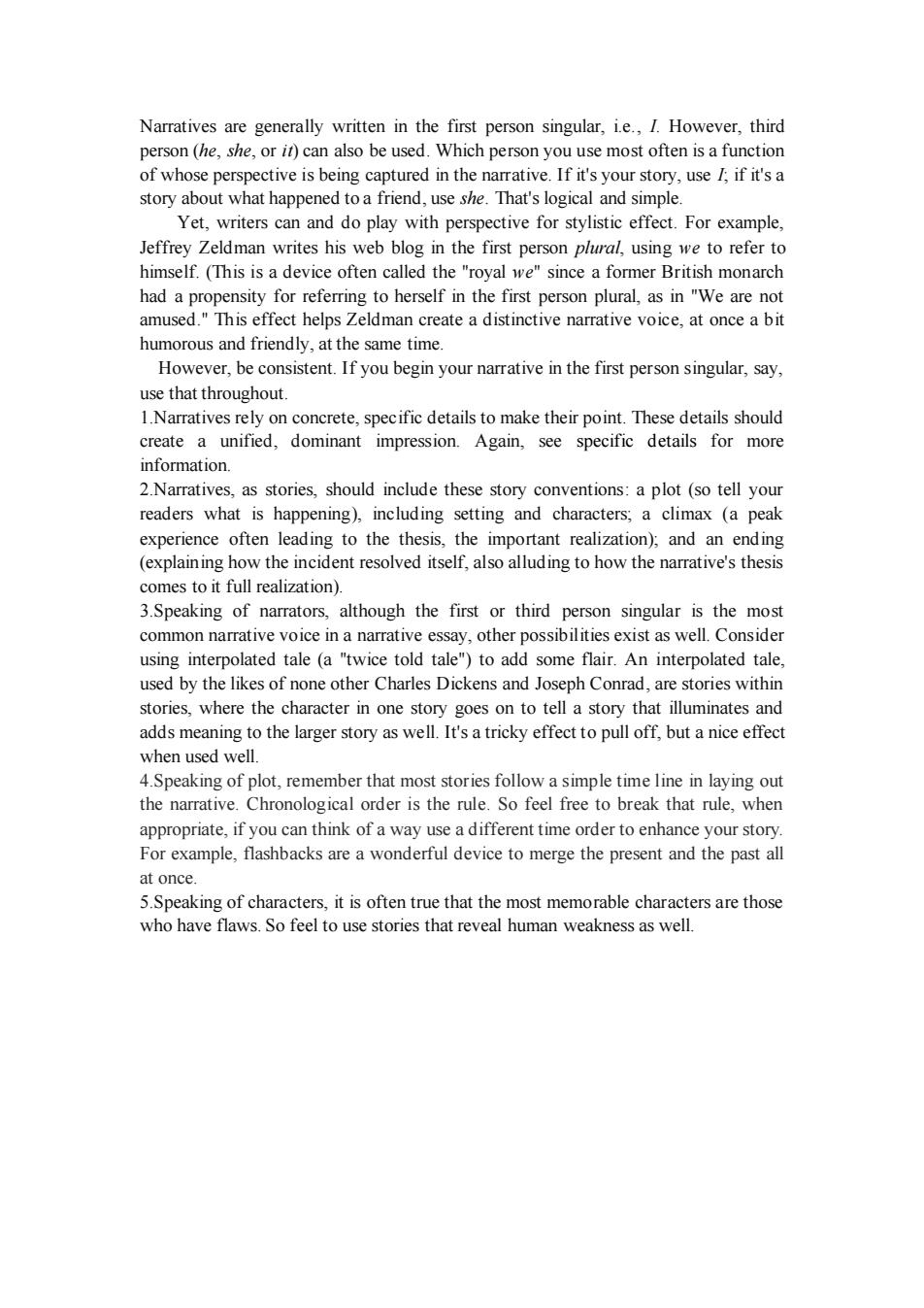正在加载图片...

Narratives are generally written in the first person singular,i.e.,I.However,third person (he,she,or it)can also be used.Which person you use most often is a function of whose perspective is being captured in the narrative.If it's your story,use I;if it's a story about what happened to a friend,use she.That's logical and simple. Yet,writers can and do play with perspective for stylistic effect.For example, Jeffrey Zeldman writes his web blog in the first person plural,using we to refer to himself.(This is a device often called the "royal we"since a former British monarch had a propensity for referring to herself in the first person plural,as in "We are not amused."This effect helps Zeldman create a distinctive narrative voice,at once a bit humorous and friendly,at the same time. However,be consistent.If you begin your narrative in the first person singular,say, use that throughout. 1.Narratives rely on concrete,specific details to make their point.These details should create a unified,dominant impression.Again,see specific details for more information. 2.Narratives,as stories,should include these story conventions:a plot (so tell your readers what is happening),including setting and characters;a climax (a peak experience often leading to the thesis,the important realization);and an ending (explaining how the incident resolved itself,also alluding to how the narrative's thesis comes to it full realization). 3.Speaking of narrators,although the first or third person singular is the most common narrative voice in a narrative essay,other possibilities exist as well.Consider using interpolated tale (a "twice told tale")to add some flair.An interpolated tale, used by the likes of none other Charles Dickens and Joseph Conrad,are stories within stories,where the character in one story goes on to tell a story that illuminates and adds meaning to the larger story as well.It's a tricky effect to pull off,but a nice effect when used well. 4.Speaking of plot,remember that most stories follow a simple time line in laying out the narrative.Chronological order is the rule.So feel free to break that rule,when appropriate,if you can think of a way use a different time order to enhance your story For example,flashbacks are a wonderful device to merge the present and the past all at once. 5.Speaking of characters,it is often true that the most memorable characters are those who have flaws.So feel to use stories that reveal human weakness as well.Narratives are generally written in the first person singular, i.e., I. However, third person (he, she, or it) can also be used. Which person you use most often is a function of whose perspective is being captured in the narrative. If it's your story, use I; if it's a story about what happened to a friend, use she. That's logical and simple. Yet, writers can and do play with perspective for stylistic effect. For example, Jeffrey Zeldman writes his web blog in the first person plural, using we to refer to himself. (This is a device often called the "royal we" since a former British monarch had a propensity for referring to herself in the first person plural, as in "We are not amused." This effect helps Zeldman create a distinctive narrative voice, at once a bit humorous and friendly, at the same time. However, be consistent. If you begin your narrative in the first person singular, say, use that throughout. 1.Narratives rely on concrete, specific details to make their point. These details should create a unified, dominant impression. Again, see specific details for more information. 2.Narratives, as stories, should include these story conventions: a plot (so tell your readers what is happening), including setting and characters; a climax (a peak experience often leading to the thesis, the important realization); and an ending (explaining how the incident resolved itself, also alluding to how the narrative's thesis comes to it full realization). 3.Speaking of narrators, although the first or third person singular is the most common narrative voice in a narrative essay, other possibilities exist as well. Consider using interpolated tale (a "twice told tale") to add some flair. An interpolated tale, used by the likes of none other Charles Dickens and Joseph Conrad, are stories within stories, where the character in one story goes on to tell a story that illuminates and adds meaning to the larger story as well. It's a tricky effect to pull off, but a nice effect when used well. 4.Speaking of plot, remember that most stories follow a simple time line in laying out the narrative. Chronological order is the rule. So feel free to break that rule, when appropriate, if you can think of a way use a different time order to enhance your story. For example, flashbacks are a wonderful device to merge the present and the past all at once. 5.Speaking of characters, it is often true that the most memorable characters are those who have flaws. So feel to use stories that reveal human weakness as well